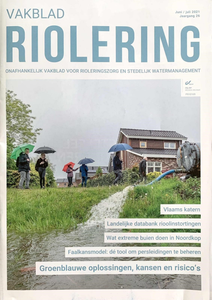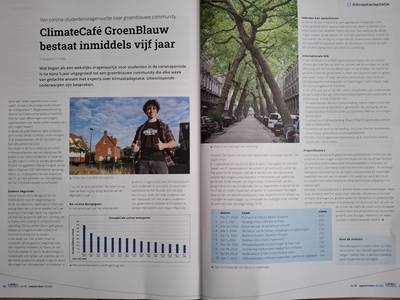Many nature-based solutions are seen as favourable and effective measures to increase urban resilience during more extreme weather events, by for example decrease high temperatures in summer. Since space is often scarce in urban environments, roofs have received increased attention in mitigating the consequences of climate change in urban areas. This resulted in a variety of roof systems of green and blue-green roofs designed as an integral part of the built environment due to their hydrological, insulative and biodiverse capacities. This study examined the impact of blue-green, and conventional roofs on roof surface temperatures, indoor temperatures and insulative properties of the building. Temperature sensors (IButtons) have been used for summer and winter measurements on roofs for early 20th century buildings in the city of Amsterdam (NL).The results indicate the strongest effect of blue-green roofs on surface temperatures in summer, with significantly lower surface temperatures (2-3°C) than for conventional roofs. During winter days, the surface temperatures were not significantly different on blue-green roofs than on conventional roofs. The measurements in the water crate layers of blue-green roofs show an all year-round temperature buffering effect. During hot summer days, the temperature in the water storage of the blue-green roof was much lower than other measured surfaces (up to 12 °C and 7 °C compared to gravel roofs and the blue-green roof substrate, respectively) and also experienced the least diurnal variation. Similarly, the empty water crate layer showed up to 3 °C higher minimum temperatures during cold winter nights. The measurements also show a small positive systematic effect on the indoor environment under a blue-green roof compared to traditional gravel roof type. The variation in indoor temperature is smaller underneath the blue-green roofs compared to the reference roofs during both warm and cold periods (0.19 – 0.35 °C reduction in STD). This suggests that rooms located under a blue-green roof are less sensitive to the outside air temperature and its natural diurnal variation.Although the effect on indoor thermal comfort seems to be small, blue-green roofs contribute to overall greening of the city. Second, thanks to the water storage the potential for growing biodiverse vegetation is higher than on extensive green roofs.
DOCUMENT
Online knowledge-sharing platforms could potentially contribute to an accelerated climate adaptation by promoting more green and blue spaces in urban areas. The implementation of small-scale nature-based solutions (NBS) such as bio(swales), green roofs, and green walls requires the involvement and enthusiasm of multiple stakeholders. This paper discusses how online citizen science platforms can stimulate stakeholder engagement and promote NBS, which is illustrated with the case of ClimateScan. Three main concerns related to online platforms are addressed: the period of relevance of the platform, the lack of knowledge about the inclusiveness and characteristics of the contributors, and the ability of sustaining a well-functioning community with limited resources. ClimateScan has adopted a “bottom–up” approach in which users have much freedom to create and update content. Within six years, this has resulted in an illustrated map with over 5000 NBS projects around the globe and an average of more than 100 visitors a day. However, points of concern are identified regarding the data quality and the aspect of community-building. Although the numbers of users are rising, only a few users have remained involved. Learning from these remaining top users and their motivations, we draw general lessons and make suggestions for stimulating long-term engagement on online knowledge-sharing platforms
DOCUMENT

''There is a clear demand for a collaborative knowledge-sharing on climate adaptation and mitigation. As a consequence of urban expansion, green spaces are lost and the available areas for pervious green areas are decreasing. Many cities will experience greater impacts from flooding and heatstress due to climate change. Blue-green and small scale Nature-based solutions (NBS) such as bio swales, raingardens and wetlands offer opportunities to adapt urban areas to the impacts of climate change, but their multiple benefits are often unknown to the wider public. Research suggests that effective management of mitigate flood events and heat stress will be achieved by applying a range of NBS measures at different locations in cities [Majidi et al 2019]. Mapping of these (potential) locations for NBS will raise awareness and contribute to capacity building on climate adaptation. Some open source Climate Change Adaptation Platforms (CCAPs) allow mapping of NBS by citizen science and can help to inform and inspire different stakeholders on the topic of climate adaptation in respective region. The aim of most CCAPs is to facilitate an open and free exchange of knowledge on an international scale. Raising awareness about climate adaptation in urban areas and promoting NBS are also key aims.''
DOCUMENT
This manifesto describes the notion of sustainable development according to its basic appeal for economic, social and environmental value-creation, together with the implications of its meaning at the level of the individual (the manager), the organisation (the business) and society. As sustainable tourism is focused on the long term, foresight is used to develop four scenarios for a sustainable tourism industry in 2040: “back to the seventies”, “captured in fear”, “unique in the world”, and “shoulders to the wheel”. The implications of the scenarios are mapped for four distinct types of organisational DNA: the blue organisation focusing on quality, professionalism and efficiency, the red organisation for whom challenge, vision and change are most important, the yellow organisation addressing energy, optimism and growth, and the green organisation which is led by care, tradition and security. The manifest concludes with strategic propositions for tourism organisations in each of the four business types and each of the four scenarios.
DOCUMENT

Closed loop or ‘circular’ production systems known as Circular Economy and Cradle to Cradle represent a unique opportunity to radically revise the currently wasteful system of production. One of the challenges of such systems is that circular products need to be both produced locally with minimum environmental footprint and simultaneously satisfy demand of global consumers. This article presents a literature review that describes the application of circular methodologies to education for sustainability, which has been slow to adopt circular systems to the curriculum. This article discusses how Bachelor and Master-level students apply their understanding of these frameworks to corporate case studies. Two assignment-related case studies are summarized, both of which analyze products that claim to be 'circular'. The students' research shows that the first case, which describes the impact of a hybrid material soda bottle, does not meet circularity criteria. The second case study, which describes products and applications of a mushroom-based material, is more sustainable. However, the students' research shows that the manufacturers have omitted transport from the environmental impact assessment and therefore the mushroom materials may not be as sustainable as the manufacturers claim. As these particular examples showed students how green advertising can be misleading, applying “ideal” circularity principles as part of experiential learning could strengthen the curriculum. Additionally, this article recommends that sustainable business curriculum should also focus on de-growth and steady-state economy, with these radical alternatives to production becoming a central focus of education of responsible citizens. https://doi.org/10.1016/j.jclepro.2019.02.005 LinkedIn: https://www.linkedin.com/in/helenkopnina/
MULTIFILE

Publicatie bij de rede, uitgesproken bij de aanvaarding van het ambt als lector Green Biotechnology aan Hogeschool Inholland te Amsterdam op 20 mei2015 door dr. C.M. Kreike
DOCUMENT

AANLEIDING - Gemeenten en waterschappen hebben de taak om te zorgen voor een klimaatbestendige inrichting van de gebouwde omgeving om schade door hevige neerslag, hitte en droogte zoveel mogelijk te voorkomen. Om die reden zijn en worden zogenaamde groenblauwe oplossingen aangelegd, zoalsinfiltrerende stadsparken, wadi's en raingardens. Er zijn echter veel vragen over het functioneren en de risico’s van deze maatregelen. Inzicht in de kansen en risico’s ontbreekt om het adequaat lange termijn functioneren van groenblauwe oplossingen te garanderen. DOELEN - Professionals van gemeenten en waterschappen hebben behoefte aan meer inzicht in groenblauwe oplossingen, zoals: 1. kansen en risico’s 2. kennis over het lange termijn functioneren; 3. interdisciplinaire samenwerking van organisaties binnen de disciplines water, bodem en groen en 4. actuele richtlijnen voor ontwerp, aanleg en beheer. Op basis hiervan is de volgende onderzoeksvraag geformuleerd voor dit onderzoek: wat zijn de kansen en risico’s bij het lange termijn functioneren van groenblauwe klimaatadaptieve oplossingen?AANPAK - Om dit te onderzoeken hebben we op meer dan zestig locaties metingen gedaan naar het functioneren van groenblauwe oplossingen. Om te voorkomen dat appels met peren werden vergeleken is daarin de focus aangebracht op de wadi als de meest populaire en langst lopende groenblauwe oplossing in Nederland. Deze werden onderzocht op hydraulisch en milieutechnisch functioneren, maar ook op eigenschappen, beleving door omwonenden en beplanting. In zogenaamde ClimateCafés werden verschillende onderzoekinstrumenten en -methodes samen met studenten, onderzoekers en professionals toegepast. De data die daarin werd opgehaald wordt vertaald naar praktische richtlijnen, gevoed met ervaringen en lessen uit interviews met professionals van publieke en private partijen (met verschillende disciplines als water, bodem, groen en stedenbouw).SAMENWERKING - Het consortium dat aan dit onderzoek werkte bestond uit een multidisciplinaire samenwerking tussen hogescholen, gemeenten, waterschappen en provincies met diverse organisaties en bedrijven vanuit het hele land. Het consortium is ontstaan uit het Lectorenplatform Delta en Water en verstevigt de strategische samenwerking tussen praktijk professionals, onderzoek en onderwijs.UITKOMSTEN - In dit onderzoek is naar een aantal eindproducten toegewerkt. Allereerst een open source database op over groenblauwe oplossingen voor inspiratie en onderzoek: Climatescan. Hierin zijn voor alle groenblauwe oplossingen die onderdeel waren van dit onderzoek de belangrijkste eigenschappen en meetresultaten gedeeld ter terugkoppeling aan de praktijk. Ten tweede een opensource database met alle onderzochte locaties en de belangrijkste analyses. Tot slot is naar een inspiratieboek toegewerkt met illustraties van goede en slechte voorbeelden uit de praktijk.
DOCUMENT

Klimaatadaptatie is booming. De transitie naar een klimaatbestendige en waterrobuust Nederland komt daarom in een versnelling. Nagenoeg elke gemeente in Nederland heeft al meerdere voorbeelden van klimaatadaptieve oplossingen gerealiseerd. Die oplossingen betekenen vaak ook een verandering van de openbare ruimte die we kennen. Daarmee nemen we steeds vaker afscheid van beproefde manieren van werken. We kijken 'ineens' anders naar riolering, bomen en wegen bijvoorbeeld. Maar is het een grote stap in het onbekende of is het gaandeweg leren?
DOCUMENT

Wat begon als een wekelijks vragenuurtje voor studenten in de corona periode is na bijna 5 jaar uitgegroeid tot een groenblauwe community die elke week van gedachte wisselt met experts over klimaatadaptatie. Uiteenlopende onderwerpen kwamen voorbij als ‘welke vegetatie hoort in een wadi?’, of ‘wat is de ecologie onder drijvende zonnepanelen’, Regenwaterbenutting: diverse technieken en praktijk voorbeelden en ook een paar afleveringen over (regen) waterkwaliteit: welke stoffen moeten we ons (geen) zorgen over maken? In de eerste jaren kwamen deze onderwerpen voorbij omdat studenten erom vroegen of ze presenteerden zelf de resultaten van hun afstudeerdonderzoek. Na 5 jaar is de focus meer op actualiteit in klimaatadaptatie met een doelgroep breder dan alleen studenten. Er staan er ca 250 videos online en worden gemiddeld 50 keer teruggekeken met hoogste aantal kijkers ca 500 keer. Gemiddelde aanwezigheid is ca 10 personen met een maximum van ca 75, deze grote aantallen worden zijn niet wenselijk om het informele karakter te behouden.
IMAGE

Groenblauwe oplossingen...we zien ze meer en meer verschijnen. Gelukkig maar, want ze zijn hard nodig met het veranderende klimaat in het achterhoofd. Binnen het project "Groenblauwe oplossingen, kansen en risico's" kijken we naar het hydraulisch en milieutechnisch functioneren van deze oplossingen op de lange termijn. Deze nieuwsbrief houdt je op de hoogte van het onderzoek, de ontwikkelingen, events en de voortgang.
DOCUMENT
